| Pages:
1
2 |
solo
International Hazard
    
Posts: 3975
Registered: 9-12-2002
Location: Estados Unidos de La Republica Mexicana
Member Is Offline
Mood: ....getting old and drowning in a sea of knowledge
|
|
Problem with monomethylation of amines.....
Recently I was posed with the task of methylating a primary amine to a secondary amine. Following an example from Freifelder chapter 11 pg #98, (see
attached file) on reductive alkylation, all was fallowed only the imine must have not formed since it didn't get warm after the addition of the
paraformaldehyde.
The solution was heated a while then left to sit....an attempt at reducing the imine with catalytic hydrogenation using Pd/C 5%, however after two
attempts in which the catalyst was replaced r/o poisoned catalyst, the reaction never happened and was left to sit over night charged with 60 psi of
Hydrogen.
Has anyone had experience methylating in this way and since the solution is at PH7 would it help if some acidic acid or some not strong acid , maybe a
dilute HCl would work.......as suggested on one of the notes of the example quoted...............solo
Attachment: page 98-99 Frifelder .pdf (547kB)
This file has been downloaded 3225 times
It's better to die on your feet, than live on your knees....Emiliano Zapata.
|
|
|
not_important
International Hazard
    
Posts: 3873
Registered: 21-7-2006
Member Is Offline
Mood: No Mood
|
|
I don't think that paraformaldehyde is going to unzip very quickly without an acid catalyst, so self-heating of the reaction mix would not be
expected.
If the HCl will not mess with your catalyst, then try it.
|
|
|
Furch
Hazard to Others
  
Posts: 130
Registered: 8-10-2006
Member Is Offline
Mood: No Mood
|
|
Why not try using the hydrochloride salt of the amine? That would give some acidity to the the reaction. Yes, protonated amines are weaker
nucleophiles than non-protonated ones, but it works in the Mannich reaction, so why not here?
\"Those who say do not know, those who know do not say.\" -Lao Tzu
|
|
|
jon
Hazard to Others
  
Posts: 459
Registered: 11-1-2006
Member Is Offline
Mood: paranoid distrustful apprehensive
|
|
paraformaldehyde depolymerizes more easily in bases, IIRC.
I would depolymerize seperately, titurate, and then procedd
[Edited on 27-4-2007 by jon]
|
|
|
solo
International Hazard
    
Posts: 3975
Registered: 9-12-2002
Location: Estados Unidos de La Republica Mexicana
Member Is Offline
Mood: ....getting old and drowning in a sea of knowledge
|
|
I recently reviewed some of my experiments and felt uncomfortable with the results of the paraformaldehyde and started reviewing my data......as I
recalled the paraformaldehyde was given to me by someone that claims to have made it......and so I examined the paraformaldehyde and found out by
doing the solubility test that it was not that at all, as this material dissolved in both alcohol and ether.......which is something it
paraformaldehyde doesn't do.......lesson learned either buy your own reactives or make them yourself .....I'm sure the person that gave it to me
though he had made it correctly, but failed to test it before giving it to me.....
As it turns out I have three failed tests on different reactions so I will be repeating them including this one.......solo
It's better to die on your feet, than live on your knees....Emiliano Zapata.
|
|
|
stoichiometric_steve
National Hazard
   
Posts: 827
Registered: 14-12-2005
Member Is Offline
Mood: satyric
|
|
solo, go here:
synth.comm. 32(3), 457-465 (2002)
this is for you! totally OTC and cheap.
|
|
|
solo
International Hazard
    
Posts: 3975
Registered: 9-12-2002
Location: Estados Unidos de La Republica Mexicana
Member Is Offline
Mood: ....getting old and drowning in a sea of knowledge
|
|
| Quote: | Originally posted by stoichiometric_steve
solo, go here:
synth.comm. 32(3), 457-465 (2002)
this is for you! totally OTC and cheap. |
Thanks for your suggestion........I knew about this route for some time and it's posted in the wanted journal references, however it's one of the
tests that I will be repeating due to the faulty paraformaldehyde used........I would be interested to know if you have first hand information on the
reaction and did it work well for you ............thank's again for your suggestion..............solo
It's better to die on your feet, than live on your knees....Emiliano Zapata.
|
|
|
stoichiometric_steve
National Hazard
   
Posts: 827
Registered: 14-12-2005
Member Is Offline
Mood: satyric
|
|
solo, i have not tested this route. please do report how it went...
|
|
|
Sandmeyer
National Hazard
   
Posts: 784
Registered: 9-1-2005
Location: Internet
Member Is Offline
Mood: abbastanza bene
|
|
Solo, Dr. X makes MDMA from MDA: http://www.erowid.org/library/books_online/pihkal/pihkal109....
| Quote: | Originally posted by Furch
Why not try using the hydrochloride salt of the amine? That would give some acidity to the the reaction. Yes, protonated amines are weaker
nucleophiles than non-protonated ones, but it works in the Mannich reaction, so why not here? |
What's the foundation for your claims? Amonia, primary and secondary amines form schiff-base electrophile (I guess that's what you meen by Mannich),
tertiary and esp. ammonium salt's do not. "protonated amines" are not just weaker nucleophiles than amines -- they are not nucleophilic at all...
|
|
|
Sandmeyer
National Hazard
   
Posts: 784
Registered: 9-1-2005
Location: Internet
Member Is Offline
Mood: abbastanza bene
|
|
Sorry for doubleposting, hive patent-master PolyetheneSam provided a US patent on preparation of p-hydroxymethamphetamine from p-hydroxyamphetamine
using formaldehyde and activated Al tunings. Description of xperimental is not of good quality, but provided it works, it is very simple and of course
compleatly over-the-counter.
Attachment: US2146473A1.pdf (83kB)
This file has been downloaded 1687 times
|
|
|
solo
International Hazard
    
Posts: 3975
Registered: 9-12-2002
Location: Estados Unidos de La Republica Mexicana
Member Is Offline
Mood: ....getting old and drowning in a sea of knowledge
|
|
| Quote: | Originally posted by stoichiometric_steve
solo, i have not tested this route. please do report how it went... |
the test run with fresh paraformaldehyde worked.....I tested the resulting amine using the Reaction with Benzenesulfonyl chloride (The Hinsberg test)
my testing material didn't precipitate under the basic solution and the precipitant didn't dissolve in the presence of Hcl , so this is a neat and
fast way to methylate some interesting amines......solo
It's better to die on your feet, than live on your knees....Emiliano Zapata.
|
|
|
stoichiometric_steve
National Hazard
   
Posts: 827
Registered: 14-12-2005
Member Is Offline
Mood: satyric
|
|
| Quote: | Originally posted by solo
| Quote: | Originally posted by stoichiometric_steve
solo, i have not tested this route. please do report how it went... |
the test run with fresh paraformaldehyde worked.....I tested the resulting amine using the Reaction with Benzenesulfonyl chloride (The Hinsberg test)
my testing material didn't precipitate under the basic solution and the precipitant didn't dissolve in the presence of Hcl , so this is a neat and
fast way to methylate some interesting amines......solo |
so it actually monomethylated? wouh - cheap! congrats.
|
|
|
solo
International Hazard
    
Posts: 3975
Registered: 9-12-2002
Location: Estados Unidos de La Republica Mexicana
Member Is Offline
Mood: ....getting old and drowning in a sea of knowledge
|
|
In my many attempts to methylate ...an amine I tried a primary amino alcohol with paraformaldehyde in ethanol......and since paraformaldehyde is
insoluble in ethanol ....after warming it I tried to hydrogenate with Pd/C but no Hydrogen was taken up.....I guess the OH interferes ........the
same thing happened with the amino acid however an odd thing happened while the solution was getting warmed up the flowery bouquet smell was all over
my lab as if though an ester had formed .....but with no acid, all there was the amino acid, paraformaldehyde and ethanol....of course the
phenylalanine never dissolved and I really wasn't looking for a oily layer of an ester or an aromatic scent to fill my lab...I wonder what sort of
reaction an acid an aldehyde in ethanol produce....I must follow this up I might have stumbled into something.........solo
It's better to die on your feet, than live on your knees....Emiliano Zapata.
|
|
|
solo
International Hazard
    
Posts: 3975
Registered: 9-12-2002
Location: Estados Unidos de La Republica Mexicana
Member Is Offline
Mood: ....getting old and drowning in a sea of knowledge
|
|
Reductive methylation of primary and secondary amines and amino acids by aqueous formaldehyde and zinc
Renato A. da Silva,a Ida´lia H. S. Estevamb and Lothar W. Biebera,
Tetrahedron Letters 48 (2007) 7680–7682
Abstract
Amines can be methylated when treated with formaldehyde and zinc in aqueous medium. Selective mono- or dimethylation can be achieved by proper choice
of pH, stoichiometry and reaction time. This method can also be applied for amino acids.
Attachment: Zn_HCHO_methylation.pdf (98kB)
This file has been downloaded 6751 times
It's better to die on your feet, than live on your knees....Emiliano Zapata.
|
|
|
solo
International Hazard
    
Posts: 3975
Registered: 9-12-2002
Location: Estados Unidos de La Republica Mexicana
Member Is Offline
Mood: ....getting old and drowning in a sea of knowledge
|
|

The result of methylating a primary amino alcohol by using formaldehyde and zinc with some NaH2PO4 with a stirred for 20 hours , then it was Ph to
11 and allowed to sit overnight........, however I need to find out the solubility of this compound.............N-methyl phynylalaninol phosphate, so
far not sol.in H2O, etOH, chloroform, ehtylacetate, toluene, .... but soluble in hypophosphorous acid, I .will check the MP it seem high there might
be a mixture of N-methyl-phenylalaninol phosphate and and NaH2PO4 salts mixed so I will soak it in H2O overnight and then dry and weight the
remaining material see if it's close to the molar amount that is expected. .....however I think the method works on primary amino alcohols will check
on amino acids........solo
[Edited on 9-11-2007 by solo]
It's better to die on your feet, than live on your knees....Emiliano Zapata.
|
|
|
Klute
International Hazard
    
Posts: 1378
Registered: 18-10-2006
Location: France
Member Is Offline
Mood: No Mood
|
|
Good work Solo! Did you try this reaction with a primary amine too, or did you only use it for the amino alcohol?
How much of an excess of yield did you obtain? How about distillation of the freebase? (Amino alcohol aren't really my thing, I don't know if this
could not lead to some deteriotion..)
In any case, thumbs up!
|
|
|
Sandmeyer
National Hazard
   
Posts: 784
Registered: 9-1-2005
Location: Internet
Member Is Offline
Mood: abbastanza bene
|
|
The method of a direct and selective mono/di-methylation is very useful, esp when OTC reagents are used -- if only the paper was written
appropriatley. Solo, to isolate your amine product, don't add amonia like they do in the paper, add some water to post reaction mixture, basify to pH
12 with conc. NaOH, extract with ether/DCM, wash org. phases with water, brine, dry (MgSO4), vac. off. the organic solvent(s).
[Edited on 1-12-2007 by Sandmeyer]
|
|
|
Klute
International Hazard
    
Posts: 1378
Registered: 18-10-2006
Location: France
Member Is Offline
Mood: No Mood
|
|
Posted by Solo:
| Quote: |
and so I examined the paraformaldehyde and found out by doing the solubility test that it was not that at all, as this material dissolved in both
alcohol and ether.......which is something it paraformaldehyde doesn't do....... |
Could it be trioxane? IIRC, it dissolves in alchol and ether... Maybe long-chained paraformaldehdye is absolutely necessary here. Did you simply
through this unknown compound away?
|
|
|
Klute
International Hazard
    
Posts: 1378
Registered: 18-10-2006
Location: France
Member Is Offline
Mood: No Mood
|
|
I'm considering the preparation of n-methylphenethylamine, by mono-methylation of 2-phenethylamine.
I have tried the above procedure using 30% HCHO and zinc dust at a 5mmol scale, but there is no way of dissolving the white zinc oxide sludge that
forms, even when adding copious amounts of 28% ammonia... Extraction is tedious, and surely incomplete. But the isolated salt seems to be mostly
mono-methylated, no visible bubbling when performing the nitrous acid test, and a few drops of yellow oil formed on surface. But the amoutn in the
test where very small (50-100mg), so even if there is 10-20% un-methylated PhEtNH2, the test might no detect it.
Anyway, I have considered doing it the Freifelder way, although using atm hydrogenation. I haven't found much info regarding the minimal pressure
required for such a hydrogenation, and if it will proceed at atm, even if it takes a long time. I ahve yet to find a effective eluant to differentiate
the primary and seconday amines by TLC, so follow up of the reaction if going to be difficult, apart from monitering H2 uptake....
Solo, would care sharing a little details on the zinc/HCHO procedure, especially the workup?
Any advice or suggestions would be most welcome
\"You can battle with a demon, you can embrace a demon; what the hell can you do with a fucking spiritual computer?\"
-Alice Parr
|
|
|
Klute
International Hazard
    
Posts: 1378
Registered: 18-10-2006
Location: France
Member Is Offline
Mood: No Mood
|
|
Here are a few pics of the zinc mediated n-monomethylation:
The phosphate salt of the amine, after dropwise addition of the freebase to a solution containing equimolar amounts of H3PO4 and NaOH:

The 30% HCHO was then added, and stirring continued for 5min: the salt started to dissolve from the sides of the flask and form a fine, milky
suspension, mild warming noticeable:
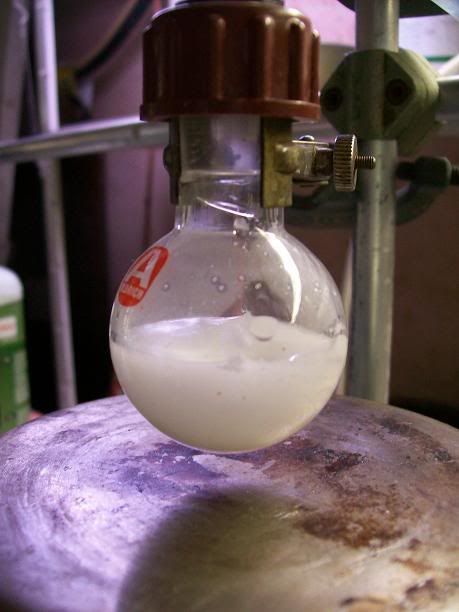
The zinc was then added over a min or so, at first forming "drops" of agglomerated zinc. The zinc gradaully thinne dout over the 3h reaction time, to
finally give a fluid suspension:
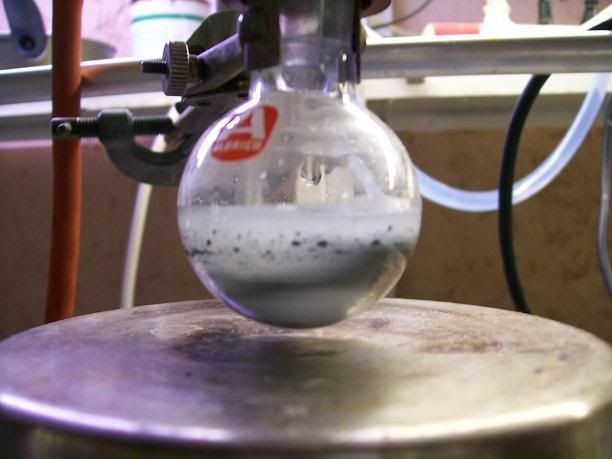
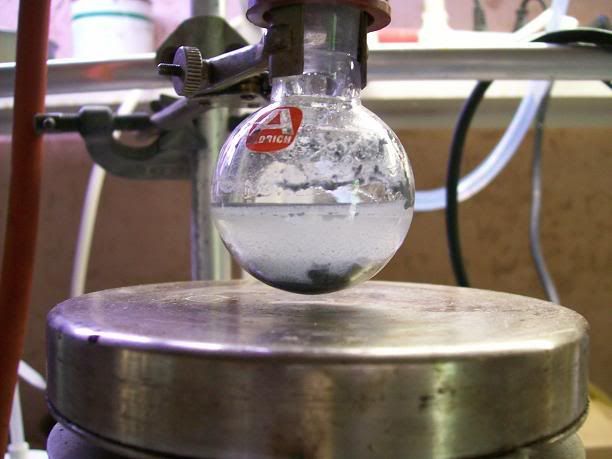
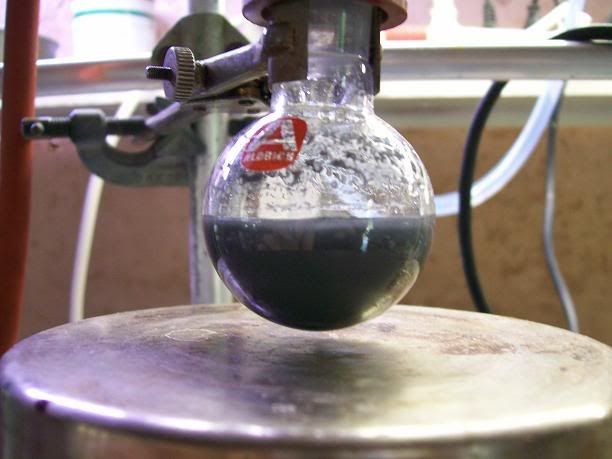
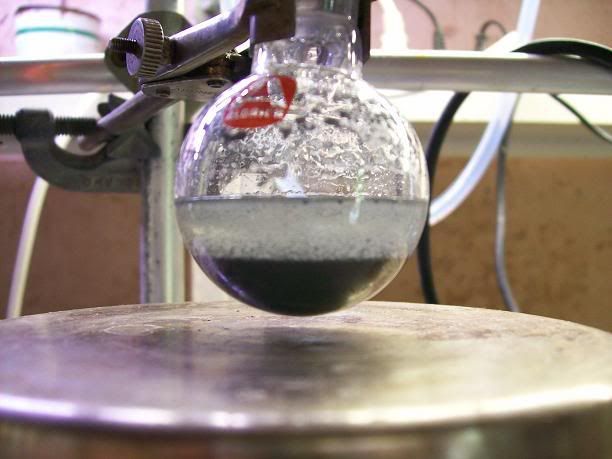
15mL of 28% ammonia was then added, without any heating up. There was some bubbling, but even after 20min stirring, the white sludge did not
dissolve:
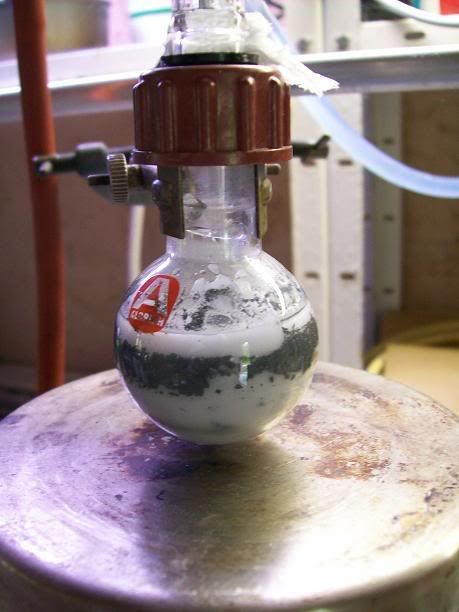
After adding 2x10 mL toluene, and seperating the organic layer with a pipette after stirring, the sludge of zinc oxide and unreacted metal was
filtered by gravity over a cotton plug, gradually adding more ammonia to the thick sludge in a vain attempt to mostly dissolve it. The obtained aq.,
very slightly yellow, was then extracted with 2x10mL toluene.
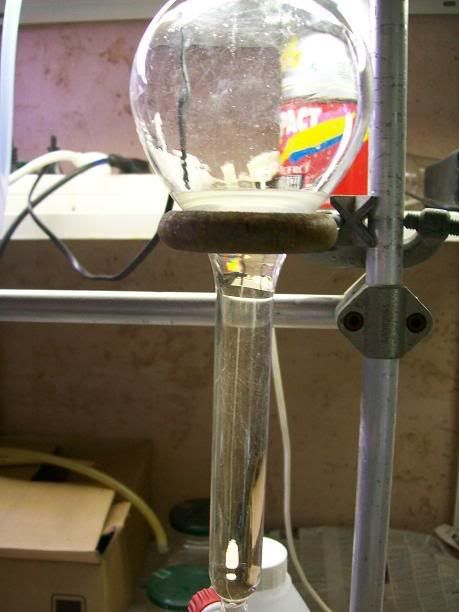

The combined extarcts where washed with 5% NH3, brine, and dried over K2CO3. 5N HCl in IPA was then added dropwise, and the fine white solid was
vacuum filtered and washed with a llittle dry pet ether:acetone 50:50.
The solid was used in a nitrous acid test, no visible bubbling, and formation of yellow droplets on the surface.
The whole sludge workup is very annoying. Obviously, I should have vacuum filtered the mess afetr briefly extracting it, but I was waiting for it to
disslove in the ammonia, I though I simply didn't add enough. If 50mL are not sufficiant for a 5mmol reaction, imagine at 100mmol..
I would really like to knwo how you did your workup Solo, to see if there is soemthing a forgot or didn't think about, or if I should directly try the
hydrogenation. I have yet to find any refs about hydrogenating formaldehyde-imines at atm pressures over Pd/C, I hope it will simply be longer than at
3 atm. The high catalyst loading is pretty annoying here too (recommended: 5g 5% Pd/C for 125mmol...)
Have you tried the hydrogeantion method succesfully (with real paraformaldehdye), Solo? Under pressure?
Thanks in advance for any advice!
\"You can battle with a demon, you can embrace a demon; what the hell can you do with a fucking spiritual computer?\"
-Alice Parr
|
|
|
Klute
International Hazard
    
Posts: 1378
Registered: 18-10-2006
Location: France
Member Is Offline
Mood: No Mood
|
|
I tried the HCHO/Zn reductive methylation on a preparative scale, 100mmol, and it didn't work out well.... There was alot of unrecated formaldehdye
(which started polymerising....), zinc, and upon workup the whole aq. turned to a very thick sludge of phosphate salts.... the toluen extarcst where
fluorescent yellow, surely indicating formaldehyde-type condensatuion products, and under 1 gr of the hydrochloride was obtained..... Thsi method is
definitively not a preparative procedure. Should ahev guessed as soon as I saw "yields where directly determined in aq. solution.." and a no
experimental part.
I will be trying the freifelder method on a 100mmol scale, trying to reduce catalyst loading, at atm pressure.
\"You can battle with a demon, you can embrace a demon; what the hell can you do with a fucking spiritual computer?\"
-Alice Parr
|
|
|
Klute
International Hazard
    
Posts: 1378
Registered: 18-10-2006
Location: France
Member Is Offline
Mood: No Mood
|
|
Trying out the freifelder hydrogenation, with >1g of 10% Pd/C at the 100mmol scale, the H2 uptake was very slow, and has now virtually ceased,
hardly 300mL absorbed after 20h......
I'm considering finishing the recation by CTH, adding concentrated ammonium formate solution. I guess the catalyst must be poisoned by something, I
will try adding a little fresh and see what happens... IIRC, there a few procedures for reductive amiantion by CTH with ammonium formate, so the
loguic woul dbe that this sytem can reduce imines. I think the imine here is already formed and pretty stable..
Ijust hate it when things do go the way you want....
EDIT: the small amount of hydrochloride obtained via the HCHO/Zn prove dto be mainly primary amine by nitrous acid test... immediate bubbling upon
adding NaNO2 solution to the ice-cold hydrochloride in aq. HCl, and no nitrosamine visible upon heating, jus-t increased bubbling....
The CTH is still been performed, but I'm already considering another approach, N-alkylation via the benzaldehyde imine.. I guess I will use
Trimethylphosphate. has anyone got experience with this method? I remeber a ref about methylating amines in neat TMP, so i guess with long enough
reaction times and reflux in toluene after imine formation (dean stark), the imine should be mostly methylated...
The whole mono-methylation issu is more annoying that what I would I thought...
EDIT2: I'm a bit worried as I ahven't found any procedures describing methylation of aliphatic amines using trialkylphosphates.... There is this orgsyn preparation describing the dimethylation of anilines, claiming that this procedure hasn't been described for aliphatic amines...
Interesting enough, when using 1 molar eq., monomethyl amines are detectable, so that means trimethylphosphate can use two methyl groups and not just
one like most O-alkylations. If using 0.66 molar eq, maybe monomethylation is possible with this smoother alkylating agent. But I'm not really in a
position to try out new things with no background information.... I've lost enough precursor as it is.
Considering that the imine between phenethylamine and (para)formaldehyde is very readibly formed (with significant heating up), I'm thinking on trying
out a "regular" reductive alkyaltion procedure, with NaBH4. It seems pretty obvious that the imine is totally formed in less than 30min owing to the
complete dissolution of the paraformaldehdye in EtOH, and if H2/Pd/C can reduce the imine without direct reduction of the aldehdye, I guess NaBH4 can
also.
So I might try the freifelder method, but adding NaBH4 instead of catalytic hydrogenation, in EtOH. What do you think?
I will see how the CTH run has gone tomorow, but the addition of a certain amount of water might have reversed part of the imine formation and lead to
reduction of the aldehyde. Seperating the primary and secondary amine isn't going to be easy without using sulfonyl chlorides...
[Edited on 29-7-2008 by Klute]
\"You can battle with a demon, you can embrace a demon; what the hell can you do with a fucking spiritual computer?\"
-Alice Parr
|
|
|
solo
International Hazard
    
Posts: 3975
Registered: 9-12-2002
Location: Estados Unidos de La Republica Mexicana
Member Is Offline
Mood: ....getting old and drowning in a sea of knowledge
|
|
Green Organic Syntheses: Organic Carbonates As Methylating Agents
PIETRO TUNDO, ALVISE PEROSA
The Chemical Record, Vol. 2, 13–23 (2002)
ABSTRACT:
Dimethylcarbonate (DMC) is a valuable methylating reagent that can replace methyl halides and dimethylsulfate in the methylation of a variety of
nucleophiles. It couples tunable reactivity and unprecedented selectivity towards mono-C- and mono-N-methylation. In addition, it is a prototype
example of a green reagent, because it is nontoxic, is made by a clean process, is biodegradable, and reacts in the presence of a catalytic amount of
base, thereby avoiding the formation of undesirable inorganic salts as by-products. Depending on the reaction conditions, DMC can be reacted under
plug-flow, CSTR, or batch conditions. Other remarkable reactions are those where DMC behaves as an oxidant. The reactivity of other carbonates is
reported as well.
Key words: methylation; dimethylcarbonate; green chemistry; phase-transfer catalysis
[Edited on 31-7-2008 by solo]
Attachment: Green Organic Syntheses- Organic Carbonates As Methylating Agents.pdf (407kB)
This file has been downloaded 2125 times
It's better to die on your feet, than live on your knees....Emiliano Zapata.
|
|
|
stoichiometric_steve
National Hazard
   
Posts: 827
Registered: 14-12-2005
Member Is Offline
Mood: satyric
|
|
| Quote: | | Originally posted by KluteI'm a bit worried as I ahven't found any procedures describing methylation of aliphatic amines using
trialkylphosphates. |
I haven't found any refs on that, either. (edit: except this one: linkinghub.elsevier.com/retrieve/pii/S0040402000010930) That doesn't mean that it's impossible, though - maybe just not a preferred route.
Why not give it a try?
[Edited on 2-8-2008 by stoichiometric_steve]
|
|
|
Klute
International Hazard
    
Posts: 1378
Registered: 18-10-2006
Location: France
Member Is Offline
Mood: No Mood
|
|
I'm currently doing the workup 
Will report results when finished!
BTW, the CTH product gave a partial positive nitrous acid test, a fair amount of orange oil, but there was quite some bubbling, so I guess I've
obtained a mixture of primary and secondary amine... I'm not too sure on how I could seperate them... Any ideas?
EDIT: I'ev found an idea, refluxing the amine freebases in ethyl formate will casue the primary amine to form a formamide, while the secondary stays
untouched, and can be isolated as a salt.. The idea came form an article detailing the reductive amination with magnesium metal...
Another idea, to use the formamide formed in that procedure, would be to methylate them with TMP (if possible), and then hydrolyze the formyl group
off... IIRC, this can be done by refluxing in HCL (leuckart)?
This article conforts me in that idea, as if DMC can methylate lactams, TMP surely can...
I'm getting more and more confortable with this reaction scheme.. This patent details the alkylation of acylate damines (most of them aromatic though), and subsequent hydrolysis by a simple hour's reflux in aq.
basic medium....
[Edited on 3-8-2008 by Klute]
\"You can battle with a demon, you can embrace a demon; what the hell can you do with a fucking spiritual computer?\"
-Alice Parr
|
|
|
| Pages:
1
2 |